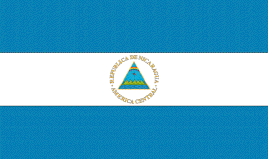
Nicaragua
|
Nicaragua History |
Click on map to see it in detail |
| Nicaragua History |
Nicaragua, which derives its name from the chief of the area's leading Indian tribe at the time of the Spanish Conquest, was first settled by the Spanish in 1522. The country won independence in 1838. For the next century, Nicaragua's politics were dominated by the competition for power between the Liberals, who were centered in the city of León, and the Conservatives, centered in Granada. To back up its support of the new Conservative government in 1909, the U.S. sent a small detachment of Marines to Nicaragua from 1912 to 1925. The Bryan-Chamorro Treaty of 1916 (terminated in 1970) gave the U.S. an option on a canal route through Nicaragua and naval bases. U.S. Marines were sent again to quell disorder after the 1924 elections. A guerrilla leader, Gen. César Augusto Sandino, fought the U.S. troops from 1927 until their withdrawal in 1933. After ordering Sandino's assassination, Gen. Anastasio Somoza García was dictator from 1936 until his own assassination in 1956. He was succeeded by his son Luis, who alternated with trusted family friends in the presidency until his death in 1967. He was succeeded by his brother, Maj. Gen. Anastasio Somoza Debayle. The Somozas ruled Nicaragua with an iron fist, reducing its dependence on banana exports, exiling political foes, and amassing a family fortune. Sandinista guerrillas, leftists who took their name from Sandino, launched an offensive in 1979. After seven weeks of fighting, Somoza fled the country on July 17, 1979. The Sandinistas assumed power two days later. On Jan. 23, 1981, the Reagan administration suspended U.S. aid, charging that Nicaragua, with the aid of Cuba and the Soviet Union, was supplying arms to rebels in El Salvador. The Sandinistas denied the charges. Later that year, Nicaraguan guerrillas known as "Contras" began a war to overthrow the Sandinistas. Elections were finally held on Nov. 4, 1984, with Daniel Ortega, the Sandinista junta coordinator, winning the presidency. The war intensified in 1986–1987. Negotiations sponsored by the Contadora (neutral Latin American) nations foundered, but Costa Rican president Oscar Arias promoted a treaty signed by Central American leaders in Aug. 1987. Violetta Barrios de Chamorro, owner of the opposition paper La Prensa, led a broad anti-Sandinista coalition to victory in the 1990 elections, ending 11 years of Sandinista rule. Enthusiasm for Chamorro gradually faded. Business groups were dissatisfied with the pace of reforms; Sandinistas, upset with what they regarded as the dismantling of their earlier achievements, threatened to take up arms again; and many people were disillusioned over governmental corruption. Former Managua mayor and Conservative candidate Arnoldo Alemán won the 1996 election. Former Sandinista leader Daniel Ortega was his closest rival. In 1998, Hurricane Mitch killed more than 9,000 people, left 2 million people homeless, and caused $10 billion in damages. Many people fled to the U.S., which offered Nicaraguans an immigration amnesty program until July 1999. Nicaragua remains one of the poorest countries in the Western Hemisphere. In Nov. 2001 presidential elections, Enrique Bolaños, the ruling Liberal party leader, defeated Ortega, who was attempting a comeback. In Aug. 2002, former president Arnoldo Alemán was charged with fraud and embezzlement, and in 2003 he was sent to prison for 20 years. Current president Bolaños triumphantly called it the "frying of the Big Fish." The anti-corruption watchdog, Transparency International, ranks Alemán among the ten most corrupt leaders of the past two decades. The country received an enormous show of support from the international community in 2004 when the IMF and World Bank forgave $4.5 billion of Nicaragua's debt. |
| Origin of the name, Nicaragua | Nicaragua is named for one of its original inhabitants, Chief Nicarao, who ruled part of the area at the time the Spanish arrived in Central America. |
Click on each link below to learn more about the symbols.
|
|
|
Nicaragua is divided into 15 departments and two autonomous regions. |
Departments
The two autonomous regions are |
| Spanish is the official language. Indigenous languages (including Mískito) and Western Caribbean Creole English are also spoken. | |
|
Since the colonial period, Nicaragua’s economy has been based on the export of raw materials, largely agricultural products. Coffee has been a major crop since the 1840s, and cotton, sugar, bananas, forestry, mining, cattle, and shrimp have also contributed to the economy.
Beginning in the 1970s, Nicaragua suffered a series of devastating events that led to an economic crisis. The country was severely damaged by civil conflicts, including the anti-Somoza revolution and then the contra war of the 1980s, at the same time it suffered natural disasters including earthquakes, floods, and hurricanes. Between 1981 and 1990 gross domestic product (GDP) per capita declined by 33.5 percent. Nicaragua’s economy has recovered somewhat since 1994, but it remains severely depressed. In 2002 Nicaragua’s GDP was $4 billion, equivalent to $750 per person, making Nicaragua one of the poorest countries in the Western Hemisphere.
|
|
Nicaragua Links |
CA - Nicaragua |
LANIC - Nicaragua Specific Links |
Source: Wikpedia the free Encyclopedia, Government of Nicaragua
Kim and Don Greene, Contributors; publication date February 2005